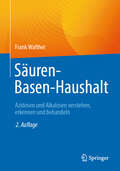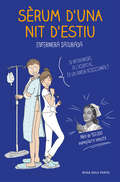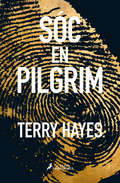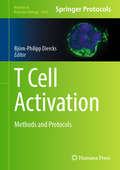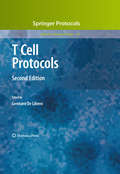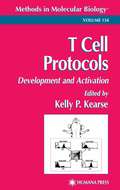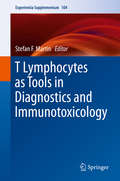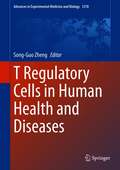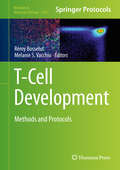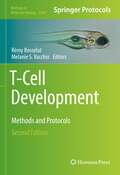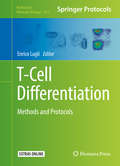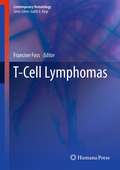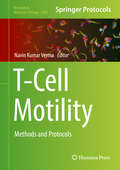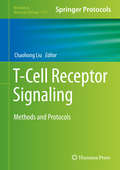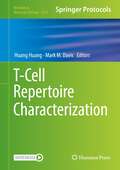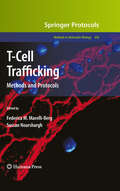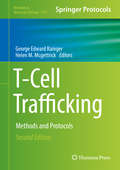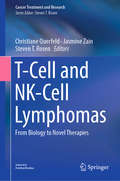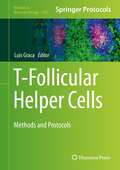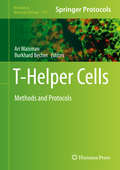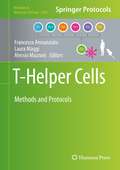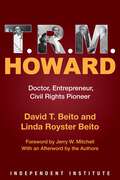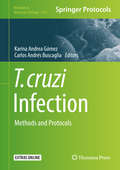- Table View
- List View
Säuren-Basen-Haushalt: Azidosen und Alkalosen verstehen, erkennen und behandeln
by Frank WaltherDieses Buch beinhaltet Grundlagen, Diagnostik und Therapie von Störungen des Säuren-Basen-Haushalts. Wer sich dafür interessiert, wie eine diabetische Ketoazidose entsteht, wie man sie behandelt, welchen Stellenwert die Therapie mit Puffersubstanzen bei Störungen des Säuren-Basen-Haushaltes hat, wie sich eine Hypothermie auf den Säuren-Basen-Haushalt auswirkt, was eine posthyperkapnische Alkalose ist, oder wer wissen möchte, wodurch sich BE- und Standardbikarbonat-Wert im Säuren-Basen-Status unterscheiden, findet die Erklärungen und Grundlagen dafür und noch etliches mehr in diesem Buch. Neben Kapiteln, die sich mit den weitgehend unveränderlichen Grundlagen und Grundsätzen der therapeutischen Möglichkeiten beschäftigen bzw. für Bereiche mit noch unzureichender Evidenzgrundlage die aktuell führenden Expertenmeinungen wiedergeben, werden zur Veranschaulichung 12 klinische Fälle präsentiert, an deren Beispiel die diagnostische Vorgehensweise bei unterschiedlichen Säuren-Basen-Störungen und die klinischen bzw. therapeutischen Schlussfolgerungen erläutert werden. Ziel des Buches ist die Vermittlung von fundiertem und praxisrelevanten, am Krankenbett einsetzbaren Wissen auf der Grundlage des Wissens aus der Biochemie und Physiologie-Ausbildung des Physikums. Es wendet sich an Ärztinnen und Ärzte verschiedener Facharztausbildungen sowie Medizinstudentinnen und -studenten. In der 2. Auflage wurde das Buch sorgfältig überarbeitet und aktualisiert und um neue Informationen ergänzt, z. B. zum Kalzium-Phosphat-Haushalt und zur 2022 erschienenen neuen Leitlinie für die Behandlung der diabetischen Ketoazidose im Kindesalter.
Sèrum d'una nit d'estiu
by Enfermera SaturadaLa Satu, la Enfermera Saturada, la Florence Nightingale de les xarxes socials, torna a la càrrega amb un llibre més il·lustrat i acolorit que mai. Haurà aconseguit la plaça fixa? Haurà trobat l'amor? O, millor encara..., tindrà ja el seu propi armariet? Cansada dels torns de nit que no s'acaben mai? La teva supervisora no col·labora en el pot de cafè i, a sobre, esmorza dues vegades? No suportes aquella companya que s'amaga al lavabo quan sona el timbre del pacient aïllat? La teva tutora et demana que prenguis la pressió amb l'aparell de l'any de la picor? No pateixis més! La Florence Nightingale de les xarxes socials ha tornat a posar-se el pijama! Aquest llibre no farà que deixis de fer torns de nit, però si més no farà que els facis amb un gran somriure. Benvinguda al nou món de la infermeria amb humor!Benvinguda al món de la Enfermera Saturada! ------- Piràmide de Maslow dels pacients ingressatsTinc visió?Em molesta la via.Conec una infermera que treballa en aquest hospital (és baixeta, morena...).Em sembla que hi ha aire al sèrum.Fa quatres dies que no cago (i me'n recordo a les 4.00 de la matinada.). Piràmide de Maslow dels acompanyants/visitesLa meva mare fa quatre dies que no caga.Com funciona la tele?En aquesta planta, hi ha el Pep, de la Lucita? El van ingressar ahir.Es que no penseu portar-li res per menjar?A quina hora passa el metge? ------- Opinions:«Un llibre molt bo.»Paco. 74. S'arrenca la via i diu que se li ha caigut. «Jo vinc a l'hospital a veure si m'hi trobo la Enfermera Saturada.»Rosa. 37. Ve a Urgències perquè té vòmits i pregunta si pot menjar alguna cosa. «Aquesta infermera és una crac. Miri, miri quin sèrum m'ha posat, ni una bombolla d'aire!»María Luisa. 56. Viu amb la por que una bombolla li prengui la vida. «M'he rigut tant amb aquest llibre que se m'han escapat unes gotetes.»Carmen. 94. Més anys que saturació d'oxigen.
Sóc en Pilgrim
by Terry HayesUna novel·la trepidant amb una acció imparable. Aquesta és la història d'una cursa trepidant contra el temps i, sobretot, contra un enemic sofisticat i implacable. En una plaça pública de l'Aràbia Saudita, un home és executat sota un sol de justícia mentre un noi de catorze anys ho observa impotent entre la multitud: és el seu fill. En un lúgubre motel de Manhattan apareix el cos sense vida d'una dona jove, però tots els indicis per identificar-la han estat esborrats minuciosament. En un abocador de Damasc troben el cadàver d'un destacat expert en biotecnologia sirià amb senyals evidents de tortura. En una remota regió de l'Afganistan, el descobriment d'una substància bacteriológica letal en els cossos d'uns cooperants internacionals desferma l'alarma. Una línia invisible connecta tots aquests fets i traça un pla perfecte per cometre uncrim monstruós contra la humanitat. L'única persona capaç d'impedir-ho és un antic agent que fuig del seu passat i que ha esborrat la seva identitat real. Ara només respon al nom de Pilgrim, el pelegrí. La crítica ha dit...«L'únic thriller que heu de llegir aquest any. Per una vegada, la pura veritat.»The Guardian «Sóc en Pilgrim és, senzillament, una de les millors novel·les de suspens que he llegit en molt de temps.»David Baldacci «Podria ser la millor novel·la d'espies de tota una generació.»Roger Hobbs «Un relat ambiciós, d'un suspens inesgotable, que deixa sense alè.»The New York Times «Un trencaclosques geopolític de realisme notable. Terry Hayes retrata el món en tota la seva complexitat i aconsegueix que la trama avanci a un ritme vertiginós.»Lire «Un thriller excepcional.»Publishers Weekly «Lectors, que no us inquieti el volum del llibre. L'argument és impecable i passareu les pàgines a tota velocitat. No podreu parar de llegir.»Booklist «Un thriller del segle XXI: un argument sofisticat amb protagonistes perfectament caracteritzats [...]. Un llibre ambiciós i molt satisfactori, escrit amb talent i vitalitat.»The Times of London
T Cell Activation: Methods and Protocols (Methods in Molecular Biology #2904)
by Björn-Philipp DiercksThis volume provides detailed, up-to-date methods used in basic and applied research on T-cell activation. Chapters explore the fundamentals in T-cell biology a board range cutting-edge techniques from initial Ca2+ live-cell imaging to downstream effector functions in autoimmune disease. Written in the format of the highly successful Methods in Molecular Biology series, each chapter includes an introduction to the topic, lists necessary materials and reagents, includes tips on troubleshooting and known pitfalls, and step-by-step, readily reproducible protocols. Authoritative and cutting-edge, T- cell activation: Methods and Protocols will be an indispensable protocol collection for researchers studying T-cell activation in inflammation and immunity.
T Cell Protocols
by Gennaro De LiberoWith a wide variety of investigative approaches, T cell immunology is a vital and open field of study. In T Cell Protocols, Second Edition, an international panel of experts contribute fully updated classic protocols as well as newly established novel techniques for the study of T lymphocyte biology. Written in the highly successful Methods in Molecular BiologyTM series format, the chapters in this volume provide brief introductions to the topics, lists of the necessary materials and reagents, step-by-step, readily reproducible laboratory protocols, and Notes sections which collect expert tips on troubleshooting and avoiding known pitfalls. Up-to-date and easy to use, T Cell Protocols, Second Edition is an ideal guide for young investigators new to the complex field of immunology as well as a valuable, concise resource for experienced scientists searching for clear, efficacious descriptions of novel methods.
T Cell Protocols
by Kelly P. KearseKelly P. Kearse and a panel of laboratory experts describe the step-by-step execution of a wide variety of basic and specialized techniques for the study of T cell developmental biology and of their subsequent activation. Readily reproducible, the techniques are explained concisely, but in such detail that they are suitable for both the novice and experienced investigator. Coverage includes treatment of both fundamental and novel experimental protocols for the analysis of the role T cells play in immune function and in the prevention and cure of human diseases. Practical and timely, T Cell Protocols: Development and Activation offers basic scientists and clinical investigators a valuable compendium of key protocols that will improve skills with existing methods, as well as afford rapid mastery of powerful new techniques.
T Helper Cell Differentiation and Their Function
by Bing SunThis book will focus on the differentiation and regulation of subsets of CD4+ T cells. It will also cover other aspects of research on these cells, which has made great advances in recent years, such as subsets' plasticity and their role in healthy and disease conditions. The book provides researchers and graduate students with a cutting-edge and comprehensive overview of essential research on CD4+ T cells.
T Lymphocytes as Tools in Diagnostics and Immunotoxicology
by Stefan F. MartinThis book summarizes the state-of-the art in the development of T cell-based in vitro assays, which offer useful tools for hazard identification, risk assessment and improvement of diagnostics. It will be of interest to scientists, the chemical and pharmaceutical industry, and regulators involved in the replacement of animal testing methods. The identification of hazardous chemicals and drugs is essential to ensuring human health. The ban on animal testing for the cosmetics industry since 2009 and international efforts to reduce and replace animal testing in research and immunotoxicology call for alternative in vitro methods. The most specific immune response to chemicals and drugs that cause allergic contact dermatitis, respiratory disease and adverse drug reactions is the highly antigen-specific T lymphocyte response. Therefore the use of T cells as tools for identifying contact allergens and drugs that may cause health problems is of great interest.
T Regulatory Cells in Human Health and Diseases (Advances in Experimental Medicine and Biology #1278)
by Song-Guo ZhengThis book addresses one of the major challenges of immunology today that is being directed to the translation of the rapidly emerging volume of basic science contributions of immunology to clinical medicine. In so doing, the book systemically introduces and discusses concepts, classifications, phenotypic and functional descriptions of regulatory T (Treg) cells in health and disease. The authors of the 15 chapters were selected from among the most qualified experts in the field of Treg cell research who provide a comprehensive overview of Treg cells and their biology in the ensuing chapters.The beginning chapters provide a useful contemporary classification of Treg cell populations and then progress to chapters that explore basic mechanisms of Treg cell function and epigenetic control. In addition to descriptions of typical CD4+ Foxp3+ cells, other chapters provide detailed presentations of Treg subsets such as CD8+ Tregs and IL-10-producing Tr1 cells. The differences of various Treg subsets, as well as circulating and resident Treg cell populations, are next compared. Importantly, the next chapters provide the clinical correlation of Treg cells with autoimmune diseases, inflammatory diseases, metabolic diseases, cancer and organ transplantation and progress to chapters that highlight emerging innovative technology including nanoparticle-Treg cells and their translational values. In summary, the book will provide a valuable resource not only for graduate students and researchers in the fields of immunology, cell biology and translational medicine but also for all others interested in learning more about Treg cells and their application in human health and disease.
T follicular Helper Cells
by Marion Espéli Michelle LintermanThis volume brings together the skills and protocols of numerous laboratories that are at the heart of investigation into the biology of Tfh cells in both mice and humans. As a volume in the highly successful Methods in Molecular Biology series, chapters contain introductions to their respective topics, lists of the necessary materials and reagents, step-by-step, readily reproducible protocols, and tips on troubleshooting and avoiding known pitfalls. Concise and easy-to-use, T follicular Helper Cells: Methods and Protocols provides scientist with techniques and protocols that have facilitated breakthroughs in Tfh biology and to present them in a way that will enable both new and experienced researchers to continue to move this exciting field forward.
T-Cell Development
by Rémy Bosselut Melanie S. VacchioThis volume provides simple and accessible experiment protocols to explore thymus biology. T-Cell Development: Methods and Protocols is divided into three parts presenting short reviews on T cell development, analysis strategies, protocols for cell preparation, flow cytometry analyses, and multiple aspects of thymocyte biology. As a volume in the highly successful Methods in Molecular Biology series, chapters contain introductions to their respective topics, lists of the necessary materials and reagents, step-by-step, readily reproducible protocols, and tips on troubleshooting and avoiding known pitfalls. Concise and easy-to-use, T-Cell Development: Methods and Protocols aims to ensure successful results in the further study of this vital field.
T-Cell Development: Methods and Protocols (Methods in Molecular Biology #2580)
by Rémy Bosselut Melanie S. VacchioThis second edition volume provides new and updated chapters detailing simple and accessible experiment protocols to explore thymus biology. Chapters are divided into three parts presenting short reviews, analysis strategies, protocols for cell preparation, flow cytometry analyses, Innate Lymphoid Cells (ILC), mouse T-cell development, antigen receptor-less cousins of T cells, bone marrow chimeras, thymic stroma, and multiple aspects of thymocyte biology. Written in the successful Methods in Molecular Biology series format, chapters include introductions to their respective topics, lists of the necessary materials and reagents, step-by-step, readily reproducible protocols, and notes on troubleshooting and avoiding known pitfalls. Authoritative and cutting-edge, T-Cell Development: Methods and Protocols, Second Edition aims to be a useful practical guide to help readers overcome obstacles associated with experimental approaches of T-cell development.
T-Cell Differentiation
by Enrico LugliThis volume provides protocols to successfully apply cutting-edge technologies to characterize the biology of T cells at an unprecedented level of complexity. Chapters guide readers through flow cytometry and fluorescence-activated cell sorting, the behaviour of single T cells after adoptive cell transfer (ACT), single cell gene expression by multiplex PCR, lentiviral transduction approaches, protocols to derive large numbers of early-differentiated memory T cells by using dedicated cytokines cocktails, approaches to measure telomerase activity in terminally differentiated T cells, and approaches to define Treg cells at the phenotypic and functional level. The final part of the book is dedicated to the analysis of the differentiation and effector functions of innate T cells, namely the well-known γ/δ T cells, and the recently identified CD8+ mucosal associated invariant T (MAIT) cells. Written in the highly successful Methods in Molecular Biology series format, chapters include introductions to their respective topics, lists of the necessary materials and reagents, step-by-step, readily reproducible laboratory protocols, and tips on troubleshooting and avoiding known pitfalls. Authoritative and cutting-edge, T-Cell Differentiation: Methods and Protocols aims to provide protocols that are fundamental to monitor the T cell compartment at the level of single cells in pathological and immunotherapy conditions.
T-Cell Lymphomas
by Francine FossThe mature T and NK cell lymphomas are rare, comprising approximately 10% of all malignant lymphomas. The incidence of T-cell lymphoma is variable around the world, with a higher incidence compared to B-cell lymphomas in the Asian basin. While the overall incidence of B-cell lymphomas has begun to decline in the United States, the incidence of T-cell lymphomas continues to rise. Over the last decade, a number of novel agents have been developed which target T-cell lymphomas and studies have identified novel genes and pathways associated with lymphomagenesis in T-cells. This comprehensive volume examines the clinical and biological aspects of the T-cell lymphoproliferative disorders in adults and children. The book includes an overview of both the cutaneous and the systemic T-cell malignancies and addresses the classification of T-cell lymphomas, the clinical features of each subtype, and the relevant molecular and genetic studies. Clinical outcomes and treatment strategies are discussed with an emphasis on the development of novel biological and targeted therapies. An outstanding resource for hematologists and oncologists, this book gathers insights from experts in the field and provides the most up-to-date information on all of the T-cell lymphoma subgroups and current and emerging therapies.
T-Cell Motility: Methods and Protocols (Methods in Molecular Biology #1930)
by Navin Kumar VermaThis volume discusses the latest developments in cellular, molecular, biochemical, and imaging assays to study the biology and functions of T-cells. The chapters in this book cover topics such as LFA-1/ICAM-1 interactions in T-cell motility; using 3D-SIM to dissect signaling cross-talks in motile T-cells; GapmeR-mediated gene silencing in motile T-cells; activity of cellular kinases in migrating T-cells; and computational analysis of protein-protein interactions in motile T-cells. Written in the highly successful Methods in Molecular Biology series format, chapters include introductions to their respective topics, lists of the necessary materials and reagents, step-by-step, readily reproducible laboratory protocols, and tips on troubleshooting and avoiding known pitfalls.Cutting-edge and comprehensive, T-Cell Motility: Methods and Protocols is an essential resource for graduate students, postdoctoral fellows, and principal investigators working in the fields of immunology, T-cell biology, biochemistry, molecular biology, and imaging.
T-Cell Receptor Signaling: Methods and Protocols (Methods in Molecular Biology #2111)
by Chaohong LiuThis volume provides current and new advanced methods and protocols to study T cells. Chapters guide readers through T cell diversity using mass cytometry, analyzing T cells from single cell level, CRISPR/Cas9 techniques to study the T cell activation, techniques to study subsets of Tcell’s, procedures to study artificial antigen presentosomes for T cell activation, techniques to study the T cell development, two-photon microscopy, and MAIT cells. Written in the highly successful Methods in Molecular Biology series format, chapters include introductions to their respective topics, lists of the necessary materials and reagents, step-by-step, readily reproducible laboratory protocols, and tips on troubleshooting and avoiding known pitfalls. Authoritative and cutting-edge, T-Cell Receptor Signaling: Methods and Protocols aims to provide a wide range of approaches and be an invaluable resource for present and future generations of T cell researchers.
T-Cell Repertoire Characterization (Methods in Molecular Biology #2574)
by Mark M. Davis Huang HuangThis volume provides a comprehensive compilation of protocols in T cell repertoire analysis, from the leading experts in the field, representing both well-established methods and cutting-edge advances. Chapters broadly cover the emerging new T cell subsets, sequencing technologies for capturing TCR repertoire, and computational tools for analyzing an ever-growing TCR repertoire, with a particular focus on how to link the sequence with TCR antigen specificity. Written in the successful Methods in Molecular Biology series format, chapters include introductions to their respective topics, lists of the necessary materials and reagents, step-by-step, readily reproducible protocols, and notes on troubleshooting and avoiding known pitfalls. Authoritative and cutting-edge, T-Cell Repertoire Characterization aims to be a useful practical guide to researches to help further their study in this field.
T-Cell Trafficking
by Federica M. Marelli-Berg Sussan NoursharghIn the last decade, a large number of major discoveries have shed light on the molecular mechanisms of lymphocyte migration and the anatomy of immune responses. In T-Cell Trafficking: Methods and Protocols, expert researchers explore how the development of novel and cutting-edge techniques, particularly in the field of real-time imaging and genetic manipulation, have led to an increased understanding of lymphocyte trafficking. Written by internationally recognized experts in their respective fields, chapters provide state-of-the-art protocols to study lymphocyte migration and T-cell: endothelial cell interactions in vitro, address various approaches used for direct visualization of the development of the lymphoid system, lymphocyte recirculation, and effector responses in experimental models in vivo, and explore lymphocyte migration and inflammation in the human system. Composed in the highly successful Methods in Molecular BiologyTM series format, each chapter contains a brief introduction, step-by-step methods, a list of necessary materials, and a Notes section which shares tips on troubleshooting and avoiding known pitfalls. Innovative and highly practical, T-Cell Trafficking: Methods and Protocols is an essential manual for newcomers in this ever-expanding and exciting area of research, as well as a valuable addition to more specialized laboratories.
T-Cell Trafficking
by George Edward Rainger Helen M. McgettrickThis second edition provides updated and new chapters on T-Cell trafficking. In addition to detailed experimental procedures, the interested reader will find informative introductory chapters on the relevance of T-Cell trafficking in thymic population and maturation, traffic through secondary lymphoid organs during 'physiological' resolving inflammation and during immune responses, as well as T-Cell trafficking in chronic inflammatory diseases. Importantly, chapters cover methods from in silico modeling of cellular interactions, in vitro adhesion assays, through ex vivo functional assays to integrated intravital modeling of T-Cell trafficking through organs. Written in the highly successful Methods in Molecular Biology series format, each methods chapter includes a short introduction to the topic, lists of the necessary materials and reagents, step-by-step, readily reproducible laboratory protocols, and tips on troubleshooting and avoiding known pitfalls. Authoritative and practical, T-Cell Trafficking: Methods and Protocols, Second Edition aims to be an essential point of reference for those new to the field of T-Cell trafficking, or to those looking to expand their technical capabilities.
T-Cell and NK-Cell Lymphomas: From Biology to Novel Therapies (Cancer Treatment and Research #176)
by Jasmine Zain Christiane Querfeld Steven T. RosenIn this book, a group of internationally distinguished lymphoma experts provide a comprehensive review of the most important advances in the biology, diagnosis, and therapy of T cell and NK cell malignancies. In particular, it demonstrates in detail how advances in our understanding of the tumor microenvironment and molecular biology have helped to elucidate the pathogenesis of these lymphomas, improve diagnostic and prognostic accuracy, and develop novel therapies that promise improved patient outcomes. Individual chapters are devoted to particular tumor types and subtypes, and all aspects of transplantation for patients with T cell and NK cell lymphomas are discussed. As such, the book offers a valuable resource for hematologists, oncologists, hematopathologists, and all those seeking an up-to-date overview of how new, targeted therapies are delivering better disease control and improved quality of life.
T-Follicular Helper Cells: Methods and Protocols (Methods in Molecular Biology #2380)
by Luis GracaThe volume provides a comprehensive overview of methods that have been developed for the study of Tfh and Tfr biology in mice, and in different human diseases. The chapters detail methods to investigate the function of Tfh cells in vivo and in vitro, including the use of mathematical models to study GC dynamics. Written in the highly successful Methods in Molecular Biology series format, chapters include introductions to their respective topics, lists of the necessary materials and reagents, step-by-step, readily reproducible laboratory protocols, and tips on troubleshooting and avoiding known pitfalls. Authoritative and cutting-edge, T-Follicular Helper Cells: Methods and Protocols aims to be a useful practical guide to researchers to help further their study in this field.
T-Helper Cells
by Ari Waisman Burkhard BecherT-Helper Cells: Methods and Protocols presents a broad selection of cutting edge protocols that will enable the reader to capture the unique features of TH cells with tools developed for the isolation of TH cells from various tissues and subsequent analysis of their functional properties in vitro, ex vivo and in vivo. Chapters cover methods of isolating T cells from various tissues in mice, protocols for the analysis of T cell function and phenotype using various cutting edge technologies, methods allowing for the manipulation of T cell function in vitro and in vivo and in vivo models of diseases in which T cells play a central role in the pathogenesis. Written in the successful Methods in Molecular Biology series format, chapters include introductions to their respective topics, lists of the necessary materials and reagents, step-by-step, readily reproducible protocols, and notes on troubleshooting and avoiding known pitfalls. Authoritative and easily accessible, T-Helper Cells: Methods and Protocols seeks to serve both professionals and novices with its well-honed methodologies in an effort to further the study of this amazingly versatile and potent cell type.
T-Helper Cells: Methods and Protocols (Methods in Molecular Biology #2285)
by Francesco Annunziato Laura Maggi Alessio MazzoniThe aim of this volume is to provide a comprehensive description of methods and protocols useful for the further study of T-helper cells. Chapters guide readers through T-helper cell recovery, molecular study, signal transduction pathways, T-cell manipulation and, last but not least, “omic” approaches. Written in the highly successful Methods in Molecular Biology series format, chapters include introductions to their respective topics, lists of the necessary materials and reagents, step-by-step, readily reproducible laboratory protocols, and tips on troubleshooting and avoiding known pitfalls. Authoritative and cutting-edge, T- Helper Cells: Methods and Protocols aims to be a useful practical guide to researches to help further their study in this field.
T. R. M. Howard: Doctor, Entrepreneur, Civil Rights Pioneer
by David T. Beito Linda Royster Beito Jerry W. MitchellT.R.M. Howard: Doctor, Entrepreneur, Civil Rights Pioneer tells the remarkable story of one of the early leaders of the Civil Rights Movement.A renaissance man, T.R.M. Howard (1908-1976) was a respected surgeon, important black community leader, and successful businessman. Howard's story reveals the importance of the black middle class, their endurance and entrepreneurship in the midst of Jim Crow, and their critical role in the early Civil Rights Movement. In this powerful biography, David T. Beito and Linda Royster Beito shine a light on the life and accomplishments of this civil rights leader. Howard founded black community organizations, organized civil rights rallies and boycotts, championed free enterprise and the Second Amendment, critiqued Big Government and socialism, mentored Medgar Evers, fought the Ku Klux Klan, and helped lead the fight for justice for Emmett Till and others. Raised in poverty and witness to racial violence from a young age, Howard was passionate about justice and equality. Ambitious, zealous, and sometimes paradoxical, T.R.M. Howard provides a complete and fascinating portrait of an important leader all too often forgotten.
T. cruzi Infection: Methods and Protocols (Methods in Molecular Biology #1955)
by Karina Andrea Gómez Carlos Andrés BuscagliaThis volume provides detailed descriptions on cutting-edge experimental methods to assess the multiple and complex interactions between T. cruzi and its host. Chapters detail a series of methods and protocols, ranging from rather classical biochemical/genetic approaches to modern, powerful and high-throughput ‘-omics’ technologies, to tackle this issue, as well as novel techniques to improve treatment and clinical evaluation of Chagasic patients. Genome-wide mining strategies aimed at identifying potential parasite antigens and vaccine candidates and an overview on the challenges and milestones encountered during T. cruzi genome assembly are also included. Written in the highly successful Methods in Molecular Biology series format, chapters include introductions to their respective topics, lists of the necessary materials and reagents, step-by-step, readily reproducible laboratory protocols, and tips on troubleshooting and avoiding known pitfalls.Authoritative and cutting-edge, T. cruzi Infection: Methods and Protocols aims to provide students, researchers, and clinicians who are interested in the study of Chagas disease an indispensable source of information.
